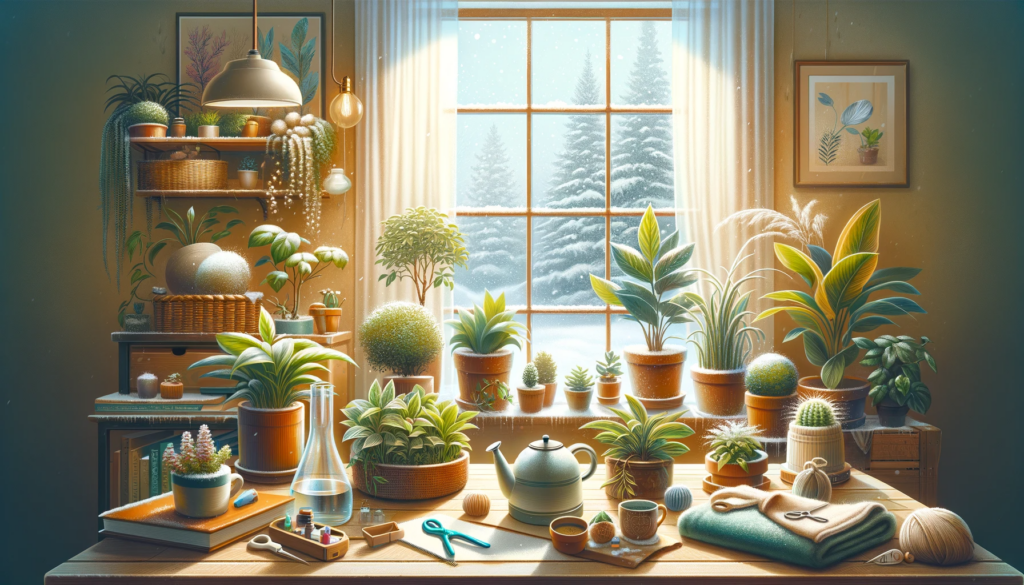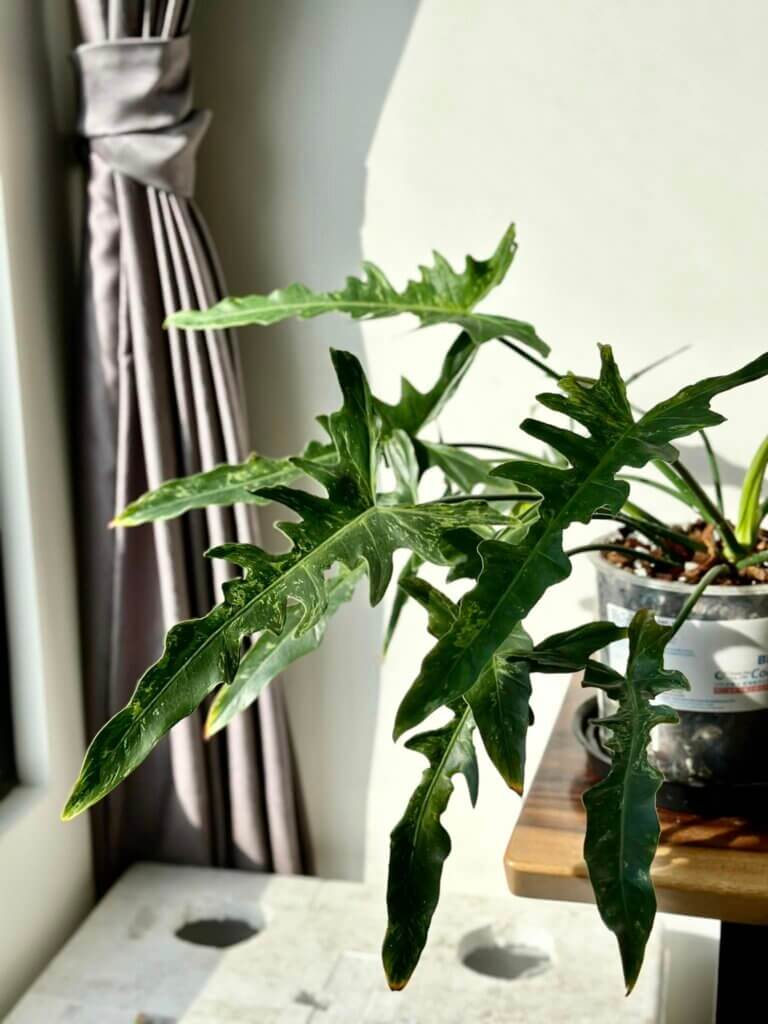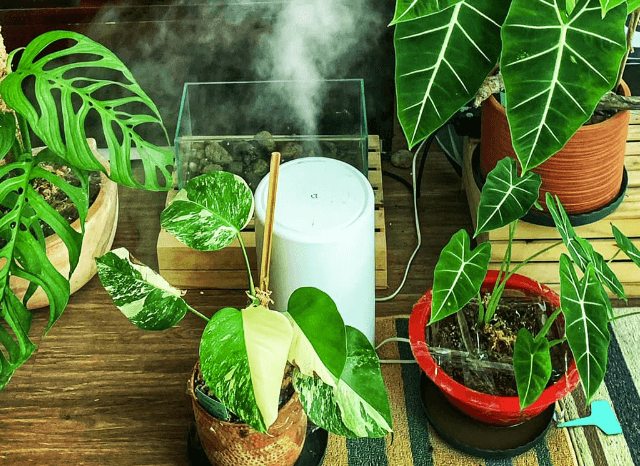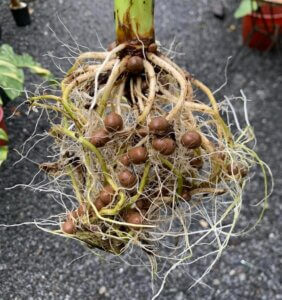With the shift in seasons, it’s crucial to adapt how you care for your indoor plants.
In this guide, we’ll unveil simple yet effective strategies to ensure your beloved houseplants thrive through the cold, dreary winter days.
Bringing a touch of nature indoors is a fantastic remedy for the winter gloom. In this article, we delve into our top seven strategies to help your indoor plants flourish even when the temperatures outside dip.

Enhance Lighting for Your Plants
During winter, the days are shorter, the sun sits lower, and cloudy skies are common. It’s crucial to ensure your houseplants receive sufficient light.
While many plants adapt to less light in their current location, some may need to be moved nearer to a window for more sunlight.
If you notice your plants leaning towards the light, gently rotate them every few days to keep them upright.
Spindly growth indicates a need for more light, so consider moving these plants closer to a window.
Another option is to introduce grow lights, which can provide extra illumination.

Understand Plant Dormancy
Just like us, plants tend to slow down in winter, with many entering a dormant or semi-dormant state due to shorter days and reduced sunlight. This impacts their water needs.
You’ll find yourself watering them less frequently than in the spring or summer. This is also why we love semi-hydro (LECA/Pon) as you don’t have to care about watering them.
For most plants, it’s best to wait until the soil is completely dry before watering again during this time.
Look for signs of thirst, such as wrinkled leaves in succulents or drooping stems in tropical plants, along with dry soil, before watering.
Pay Attention to Temperature Changes
Rapid temperature changes or drafts, whether cold or hot, can stress indoor plants accustomed to stable environments.
Avoid placing your plants near open windows, doors, heating units, or radiators, as these can lead to rapid drying.
Some plants are particularly sensitive to cold, but generally, if you’re feeling cold, your plants probably are too.
The ideal temperature for most houseplants is around 75°F (24°C).
Keep Leaves Clean
In winter, with windows mostly shut, dust and indoor pollutants can accumulate more readily.
This build-up on the leaves of your plants can hinder their ability to absorb light. Given the shorter daylight hours, it’s vital that your plants get as much light as possible.
Assist them by gently wiping their leaves every few weeks with a soft, damp cloth, possibly with a drop of lemon juice or mild soap added.
Pause Fertilization
During winter, plants slow down in all aspects, including their need for nutrients. It’s best to hold off on fertilizing until spring.
However, if you’re actively growing a plant under sufficient light, a reduced amount of fertilizer (half strength or less) can be beneficial.
You don’t have to cut it down if you make sure that your house is warm enough, and you are using grow light.
Understand Natural Leaf Shedding
It’s normal for houseplants to shed some leaves in fall and winter as a natural response to less light and reduced food availability.
If your plant flourished in the warmer months but seems to be losing leaves now, don’t be alarmed. It’s merely adjusting to seasonal changes.
If your plant appears overgrown, you can trim a few older leaves. This not only prevents further leaf shedding but also keeps your plant looking fuller.

Control Humidity Levels
Winter heating often dries out indoor air, which can be a challenge for humidity-loving houseplants.
To counteract this, consider using a humidifier in your plant area, which can significantly improve the ambient moisture levels.
Alternatively, you can place water trays near your plants to increase humidity naturally, or group plants together, creating a mini ecosystem where they can benefit from each other’s transpiration.
Ensuring adequate humidity will keep your plants looking fresh and vibrant throughout the winter months.
Regular Pest Inspections
In the cozy confines of your winter home, houseplants can become more susceptible to pests like spider mites, mealybugs, and thrips. Regularly inspect your plants, especially under leaves and at stem joints, for any signs of infestation.
If you spot pests, address them promptly using natural methods such as neem oil or insecticidal soap.
Keeping your plants clean and maintaining good air circulation around them also helps in preventing pest outbreaks.
A healthy plant in a well-maintained environment is less likely to succumb to pest attacks.
Monitor Soil Moisture Accurately
Overwatering is a common issue in winter, as plants use less water due to reduced sunlight and growth rates. This is also why we love growing houseplants in a semi-hydroponic system, or even using pumice, to stop worrying about things like this.
To prevent this, it’s important to monitor the soil moisture levels before watering.
You can use a simple tool like a moisture meter to check how wet the soil is beneath the surface.
Alternatively, the finger test – inserting a finger into the soil up to the first knuckle – can also give you a good idea of the moisture level. If the soil feels dry at that depth, it’s time to water; if not, it’s best to wait.
This practice helps avoid root rot and other water-related issues.
Consider Water Quality
The quality of water you use can significantly impact your plants, especially in winter when they are more vulnerable.
Tap water, particularly if it’s softened or high in minerals, can accumulate salts in the soil, potentially harming the plants.
To avoid this, consider using rainwater or distilled water for watering your plants. These alternatives are gentler and can help prevent the buildup of unwanted minerals in the soil, ensuring your plants stay healthy and hydrated.
Carefree Plant Care During Travel
Planning a winter getaway? Here’s how to ensure your plants stay healthy in your absence.
Consider a plant sitter, or alternatively, move your plants slightly away from their light source and water them thoroughly before leaving.
This reduces their water consumption due to the temporary light deficit, preventing them from drying out.
Remember, plants generally need less attention in winter.
If your trip is a week or shorter, they’ll likely be fine without any special preparations.

Avoid Repotting in Winter
Winter is not the ideal time for repotting houseplants. During these colder months, plants are often in a dormant state and can struggle to adapt to a new pot or soil.
Unless it’s absolutely necessary (like in cases of root rot or severe overcrowding), save repotting for the spring when plants are entering their growth phase and can recover more easily from the stress of repotting.
This pause in repotting will also prevent disturbing the plant’s root system when it’s most vulnerable.
Gentle Pruning and Cutting
While extensive pruning is best left for spring, winter is a good time for gentle cutting of your houseplants. This involves removing any dead or yellowing leaves, which not only improves the plant’s appearance but also its overall health.
Trimming helps the plant to focus its energy on the healthy leaves, leading to better growth. Be sure to use clean, sharp scissors or pruning shears for this task to avoid damaging the plant.

